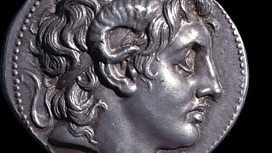Harem wall painting fragments
Neil MacGregor's world history as told through objects at the British Museum. Today he is with the women of Samarra in Iraq
Neil MacGregor's world history as told through objects at the British Museum. This week, he is exploring life and intrigue in the great courts of the world at the same time as the European medieval period. Today he is with the women of Samarra in Iraq. This ancient city, north of Baghdad, was once home to the Abbasid court and was one of the great Muslim capitals of the world. Portraits from a mural in the palace harem offer a vivid insight into the lives of the rulers and the slave women whose job was to entertain them. What was life really like in this great court?
The historian Robert Irwin, an expert on the tales of the Arabian Nights, looks at how the reality of life in the harem matches the sensual fantasy that has become associated with the period. And Amira Bennison, of Cambridge University, explains what conditions were like for the women of the harem and the qualifications they needed just to get there.
Producer: Anthony Denselow
Last on
![]()
More programmes from A History of the World in 100 Objects related to leaders & government
About this object
Location: Samarra, Iraq
Culture: Ancient Middle East
Period: 9th century AD
Material: Paint and Stone
��
The two figures, displayed on these wall painting fragments, are probably slave girls from the harem of Caliph al-Muasim in Samarra. Although simply drawn, they have a distinct personality and conjure up images of the Arabian Nights stories, some of which were set in Samarra. The women of the palace were not just wives and concubines but were also poets and musicians. Harem girls were often highly trained in singing, music and literature and it was potentially an attractive career for a woman of humble origins.
What happened to Samarra?
Samarra was built as the new capital of the Islamic Empire in AD 836 and, at the time, was one of the largest cities in the world. Samarra was created to house the Caliph's court and army of Turkish slavesoldiers, after they increasingly came into conflict with the inhabitants of Baghdad. In AD 861, after the Turkish commanders assassinated the Caliph al-Mutawakkil, Samarra was abandoned. Samarra's decline mirrors that of the Islamic Empire, which became increasingly fragmented from AD 800 onwards.
Did you know?
- The narrator of the Arabian Nights, Scheherazade, is a female story-teller, perhaps like the figures in the paintings.
A real career move
By Amira Bennison, Senior lecturer in Middle Eastern and Islamic Studies, University of Cambridge
��
Slave girls could come from any part of the world. In Islam you are not technically allowed to enslave Muslims, so most of these girls come from border territories – from central Asia, from Ethiopia, from the Basque Country in Northern Spain. And they were actually brought first of all to training centres, one of the most important being the city of Medina in Arabia which was renowned in the Abbasid period as a place where girls could learn to play musical instruments like the Oud (the lute) and also learn poetry and dance.
It was only after they had been trained that they were purchased and brought into other households. Not only the Abbasid Royal households in Samarra but also royal households in Cairo and in Cordoba in Islamic Spain.
The freedom of slave girls was often slightly greater than that of free women in the sense that they did not have the same reputation to protect as free born women. To become part of the Caliph’s household (perhaps household is a better word than harem) was actually something women could aspire to and if you were of humble origins but you were good at singing or dancing and you got properly trained then this was a real career move.
Transcript
Broadcasts
- Tue 15 Jun 2010 09:45����ý Radio 4 FM
- Tue 15 Jun 2010 19:45����ý Radio 4
- Wed 16 Jun 2010 00:30����ý Radio 4
- Tue 15 Jun 2021 13:45����ý Radio 4
Featured in...
![]()
Leaders and Government—A History of the World in 100 Objects
More programmes from A History of the World in 100 Objects related to leaders & government
Podcast
-
![]()
A History of the World in 100 Objects
Director of the British Museum, Neil MacGregor, retells humanity's history through objects





